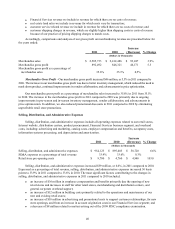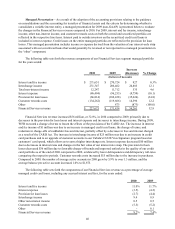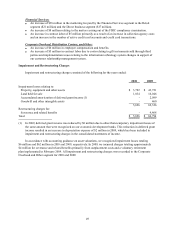Cabela's 2011 Annual Report Download - page 58
Download and view the complete annual report
Please find page 58 of the 2011 Cabela's annual report below. You can navigate through the pages in the report by either clicking on the pages listed below, or by using the keyword search tool below to find specific information within the annual report.
48
Merchandise Gross Margin – Our merchandise gross profit was flat in 2010 (52 weeks) compared to 2009
(53 weeks). On a comparable 52-week basis, merchandise gross profit improved in 2010 primarily due to better
inventory management, which reduced the need to mark down product, continued improvements in vendor
collaboration, and advancements in price optimization. These improvements, which started in the second quarter of
2010, were partially mitigated due to management’s efforts to reduce aged and unproductive inventory in the first
half of 2010.
Our merchandise gross margin as a percentage of revenue of our merchandising business increased to 35.1%
in 2010 from 34.6% in 2009. The increase in the merchandise gross margin for 2010 compared to 2009 is primarily
due to ongoing improvements during 2010 in inventory management, vendor collaboration, and advancements in
price optimization. The increase is also attributable to a shift in 2009 in customer preference toward lower margin
ammunition, firearms, and related products, and the impact from higher 2009 merchandising revenue compared
to 2010.
Selling, Distribution, and Administrative Expenses
Selling, distribution, and administrative expenses were as follows for the years ended:
2010 2009
Increase
(Decrease) % Change
(Dollars in Thousands)
Selling, distribution, and administrative expenses $ 895,405 $ 870,147 $ 25,258 2.9%
SD&A expenses as a percentage of total revenue 33.6% 33.1% 0.5%
Retail store pre-opening costs $ 4,760 $ 3,694 $ 1,066 28.9
Selling, distribution, and administrative expenses increased $25 million, or 2.9%, in 2010 (52 weeks) compared
to 2009 (53 weeks). Expressed as a percentage of total revenue, selling, distribution, and administrative expenses
increased 50 basis points to 33.6% in 2010 compared to 33.1% in 2009. The most significant factors contributing to the
changes in selling, distribution, and administrative expenses in 2010 compared to 2009 included:
• an increase of $11 million in contract labor due to costs relating to gift instruments sold through third
parties, collection agency costs of our Financial Services business, and implementation issues relating to
the information technology system changes in support of our customer relationship management system;
• an increase of $11 million in employee compensation and benefits partially due to the opening of our Grand
Junction, Colorado, retail store and increases in staff of our merchandising and inventory logistics teams;
• a decrease of $9 million in catalog and Internet marketing costs; and
• an increase of $8 million in operating expenses relating to matters arising out of the FDIC
compliance examination.
Significant selling, distribution, and administrative expense increases and decreases related to specific
business segments included the following:
Retail Business Segment:
• An increase in marketing fees of $21 million received from the Financial Services segment.
• A net increase in employee compensation and benefits of $4 million primarily due to the opening of our
Grand Junction, Colorado, retail store.
Direct Business Segment:
• An increase in marketing fees of $17 million received from the Financial Services segment.
• A decrease in catalog and Internet related marketing costs of $9 million compared to 2009 primarily due
to a managed reduction in catalog page count.
• An increase in bad debt expense of $5 million from estimated losses of customer receivables.
























